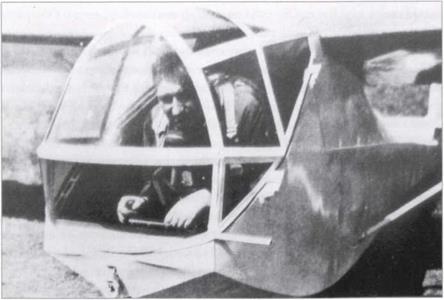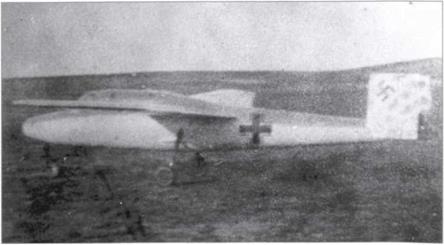The Baptism of Fire
The heavy Luftwaffe losses led to ever younger pilots filling the gaps in the ranks. Both the NSFK and the Hitler Youth could not remain inactive. New operational pilots, especially for the He 162, were to be trained at the Reich Glider School at Trebbin, and also at Laucha and Brno from the end of January 1945. At all three aerodromes, training was arranged for the Me 163 and other types kept secret from the novices, perhaps the Natter.
The ‘total mission had been rejected by Hitler in principle, but from the beginning of the year had numerous advocates, amongst them the famous female aviator Hanna Reitsch. What the young candidates were actually being trained for seems to have been a mystery to all involved. Ever greater importance, as was obvious, was being attached to the He 162. A whole Geschwader was to be equipped with it. The idea of giving the second formation the name HitlerJugend was received with enthusiasm in the ranks of the boyish heroes and their promoters. It was necessary to press ahead as soon as possible but as neither the required infrastructure nor airworthy He 162s were available for the planned training, instruction tended to be mainly theoretical.
From the end of November 1944 therefore, life was breathed into Recruitment Group Oesau by accepting volunteers born in 1928 for training in theory at Luftkriegsschule 1, Dresden-Klotzsche, from where they would be drafted to Oschatz in central Germany for continuation training as fighter pilots. A training company and supply unit were set up from the various recruitment groups. In February 1945 Kompanie Oesau was spread between Celle and a holding camp at Goslau instead of Dresden. This was a unit whose personnel were to be used as ‘fighter pilots recruited for special purposes’ and then – depending how things turned out – as infantry. Once aviator training was dissolved, many of the pilots went to recendy formed anti-tank commandos.
Most of the barely 17- or 18-year-old pilots still believed, on the basis of assurances given by their superiors, that there would be a chance to fly the Natter, over which the SS had great influence, or the Volksjager if things changed. Behind the scenes the power struggle between the Party (that is the SS, NSFK and Hider Youth) and the Luftwaffe raged on. The Reich Youth leader attempted to shrug off NSFK influence by making a deal with the SS. Meanwhile Himmler had accepted the Natter, successfully test flown by Oberstleutnant Siegfried Knemeyer, despite Luftwaffe objections that it was included in their projects classified as ‘manned flak rockets’. The machine was a ‘disposable’ unit from which the pilot would bale out after firing his Fohn rockets. The idea of a ‘Luftwaffe Suicide Division’, openly proposed by Generalmajor Walter Storp during his stint as General der Flieger to 31 January 1945, also found a reception at the RLM. Most at OKL, and Hider himself, were opposed to suicide missions of all kinds, but could not always prevent them, although they remained few.
As development of the Natter and other aircraft needed time, the NSFK attempted to conjure up at least a couple of He 162s. In mid-February 1945 work had barely begun on the first two planned training machines with an engine. The He 162 training glider built by the NSFK at Dresden was flight- tested for the first time at Trebbin on 1 March 1945. In the provisional judgement of veteran airmen the aircraft was unsuitable for Hitler Youth pilots, being so unstable that the planned run of prototypes had to be halted while attempts were made to improve the design. Time was lacking in which to turn out a useful glider tug after production centres in the Erzgebirge came under threat from the Red Army sooner than expected.
Besides the single-seater with normal surfaces (as a glider), work on a two-seat trainer with greater wing surfaces began. The fourth variant in preparation at the beginning of 1945 was a two-seater with BMW 003 E-l turbine at DLH Oranienburg. Due to under-capacity the prototype engine for the two planned experimental machines was never completed at Heinkel-Siid Heidfeld/Vienna, as was the case with all other mixed-construction He 162 trainers. In the end, none left the works. So long as it remained possible, training and instruction was given in the hangars, but youthful dreams of the aviator’s life now faced an imminent end.
On 19 March training for fighter pilot recruitment in Bohemia was abandoned upon the approach of the Red Army, and as a result the NSFK agreed with OKL to concentrate practical flying training mainly in central Germany. After even the meagre requirements for two geographically separate training institutions could no longer be met, the best candidates from each of the three
|
At least one Grunau Baby glider was fitted experimentally with a cockpit in which the pilot could fly the machine in the prone position. |
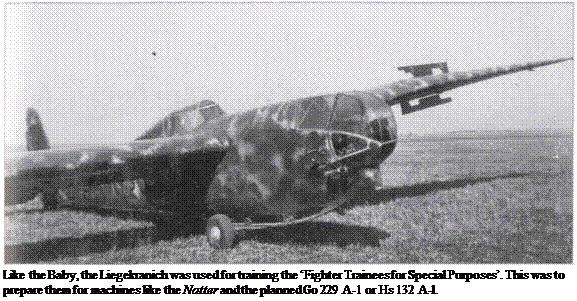
schools were assembled at Trebbin. The Reich Glider School belonged to 4. Group NSFK Berlin/Mark Brandenburg. In comparison to the unit at Brno, the school was relatively well equipped at the beginning of 1945.The last course began at the end of March, some of the trainees having been transferred in from Laucha and Brno.
According to the diary entry of instructor Georg Cordt, in the second half of March there was at least one He 162 training aircraft in its component parts in one of the hangars at Trebbin. On 26 March construction of the machines began and two days later several flying instructors attached to the course for ‘Fighter Pilot Recruitment for Special Purposes’ made at least seven flights in the unpowered school glider, an especially powerful winch being used for the takeoffs. On 29 March an aircraft was used as a tug. On 8 April the famous aviator Hanna Reitsch arrived unannounced in her Bii 131 and flew for the first and probably only time over Trebbin airfield in the He 162 S. Meanwhile motorised training flights at the Reich Glider School had been ordered severely restricted. Constant air alarms made any useful work on the ground or in the air extremely difficult and although some flying was done it could not be called very useful.
From 15 April flying routine gave way to Panzerfaust training. This involved firing the weapon at a wooden mock-up of a T-34 and at targets set up in the terrain. That their future role in the war, whether trainee or instructor, would be as ground troops became ever clearer. A few days previously Oesau units at Celle and Goslar with a total strength of 1,500 men were ordered to prepare for the
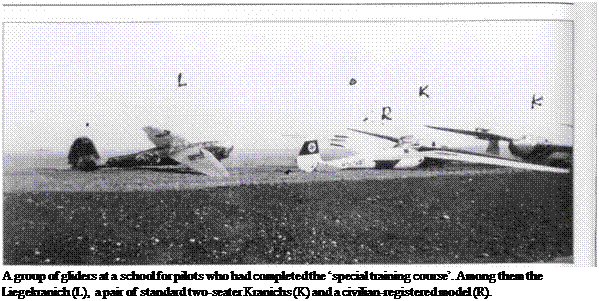
front. On 1 April 1. Kompanie Oesau at Celle was raised to Bataillon Oesau of three companies. On 6 April 2. Kompanie Oesau, also of battalion size, went direcdy from Goslar to the front. Only two weeks later, on 21 April at the hamlet of Michelstein, the battalion had been reduced to 65, all others being dead, wounded or missing in action. The survivors served as ‘paratroops’ on the so – called ‘Innermost Line’.
|
Probably only a single version of the two-seater unpowered He 162 S training glider was built and flown at the Reich Glider School atTrebbin near Berlin. |
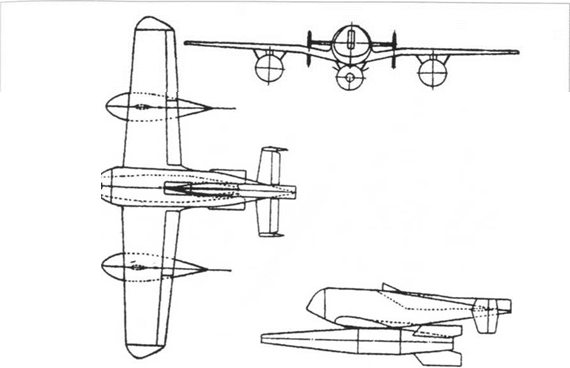
Numerous weapons for pin-point bombing, such as this ‘Special Machine with Bomb – Torpedo 1400’were projected from 1944 onwards. They would have demanded kamikaze tactics from the pilot.
On 20 April the Special Course at Trebbin was dissolved and all personnel at the Reich Glider School were attached to the newly formed Division Friedrich Ludwig Jahn of Twelfth Army, for the defence of Berlin. During the heavy fighting around Potsdam, the unit was encircled for a while but reached German lines after sustaining heavy losses. Casualties rose. One of two Hitler Youth companies was reduced to 14 boys, the other, including its company commander, fell in the field. Shordy afterwards the surviving unit broke up and its members sought refuge in flight.











